This morning we had a walking tour around Essaouira with a woman named Rashida, who was quite literally the first Moroccan woman we have really interacted with. Generally speaking, while there are women cooking in the guesthouses we have stayed in or cleaning etc in the hotels, we have not really been able to interact with women in Morocco. In most places all the shop keeps are men, all the guides, drivers and hosts are men, and the women are largely unseen. Rashida is also a bit of an oddity as she is a Gen X lady who has a university education and worked as a teacher for many years, so we were very hopeful of a lot of information from her. Our first port of call on our walking tour (pun intended) was the harbour where much of the local fishing industry is carried out.
Our first port of call on our walking tour (pun intended) was the harbour where much of the local fishing industry is carried out. 
 Local fishermen will bring in their catch here and a bustling and busy wholesale fish auction occur every morning – except this morning, which is Sunday. Historically, Essaouira has been occupied since prehistoric times as the bay is fairly adequately protected by Mogador Island, which makes it a very peaceful and protected harbour from the strong Atlantic winds.
Local fishermen will bring in their catch here and a bustling and busy wholesale fish auction occur every morning – except this morning, which is Sunday. Historically, Essaouira has been occupied since prehistoric times as the bay is fairly adequately protected by Mogador Island, which makes it a very peaceful and protected harbour from the strong Atlantic winds.
Essaouira has long been one of the best anchorages on the entire Moroccan coast. A Carthaginian navigator named Hanno wrote of coming here in the 5thC BC to establish a trading post, which made it a strategically important location over the following 2500 years.. Boats here, like in many other countries, are female – and will have a name painted on them. Many of the names are Spanish, Portuguese, or even English, so we could see the Christina or the Maria nearby. The fishermen here are required to paint their boats blue, as they believed that flies are not able to see the blue colour..?
Boats here, like in many other countries, are female – and will have a name painted on them. Many of the names are Spanish, Portuguese, or even English, so we could see the Christina or the Maria nearby. The fishermen here are required to paint their boats blue, as they believed that flies are not able to see the blue colour..?
While we were at the dock, a small boat pulled in a 14′ shark, Rashida called it a ‘clown shark’ but with it’s very long tail fin, it looked like an endangered thresher shark to most of the divers in our group. This shark is destined for the fish markets and will be eaten.
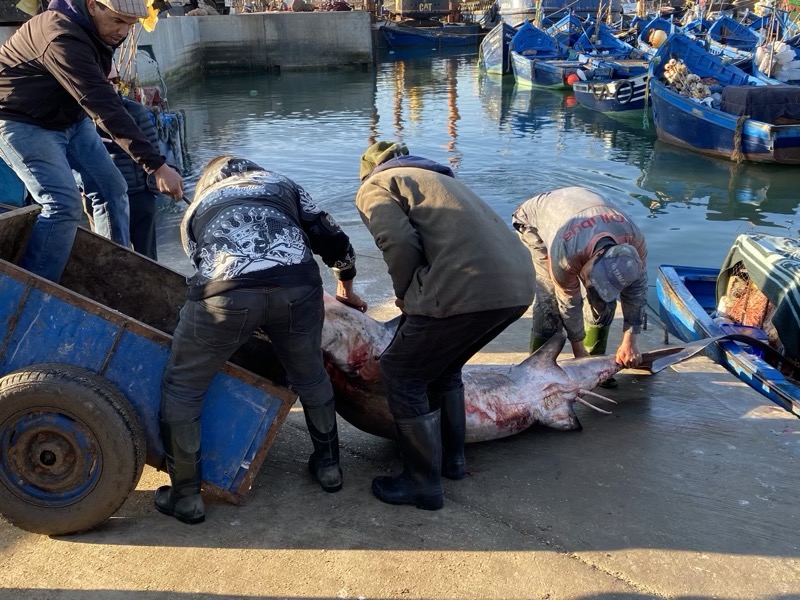
 In the 16thC, Essaouira was occupied by Portugal, ad the King at the time, Manuel I ordered a fortress to be built here – it was called the Castelo Real de Mogador – Essaouira was known as Mogador up until the 1960s. By that time, the Portuguese had control of six Moroccan coastal towns and had built a stand-alone fortress in each town from the start of their occupation in the mid 15thC Most of them were short-lived, being only held for between 5-25 years… by 1541, the fortress at Agadir had fallen to the Saardians (that was the Arab-Moroccan dynasty that ruled Morocco from 1549-1659) and the Portuguese had to abandon all the settlements they had occupied managing only to hold onto Tangier, Cuta and Mazagan.
In the 16thC, Essaouira was occupied by Portugal, ad the King at the time, Manuel I ordered a fortress to be built here – it was called the Castelo Real de Mogador – Essaouira was known as Mogador up until the 1960s. By that time, the Portuguese had control of six Moroccan coastal towns and had built a stand-alone fortress in each town from the start of their occupation in the mid 15thC Most of them were short-lived, being only held for between 5-25 years… by 1541, the fortress at Agadir had fallen to the Saardians (that was the Arab-Moroccan dynasty that ruled Morocco from 1549-1659) and the Portuguese had to abandon all the settlements they had occupied managing only to hold onto Tangier, Cuta and Mazagan.
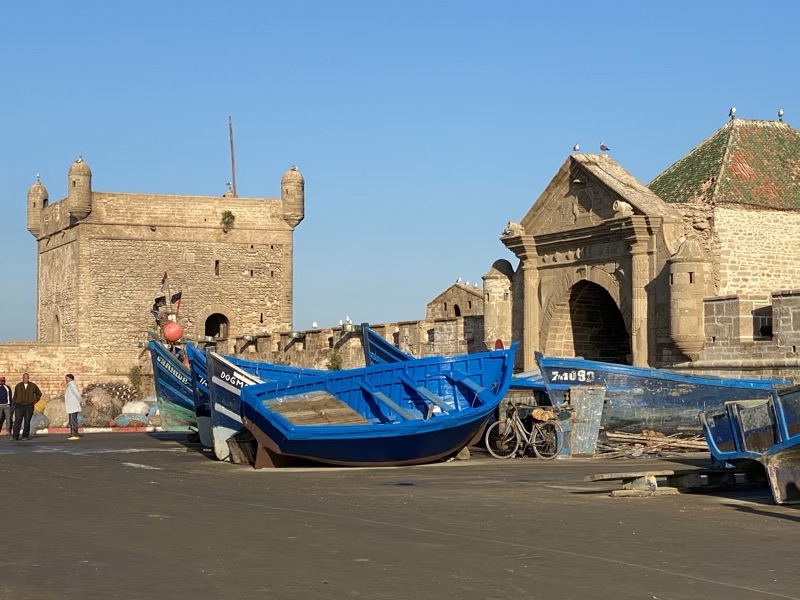

During the following century, several European powers including Spain, England, the Netherlands and France all tried to conquer the region without success and Essaouira remained a haven for the sugar exports of sugar and molasses, and as favourite anchorage for pirates. Yarrrr. Various parts of the fortifications were built and extended on from that time onwards. The present fortifications were built in the 1700s by various French architects – Rashida tells us Moroccans know how to build things, but are not very good at maintaining them.
Various parts of the fortifications were built and extended on from that time onwards. The present fortifications were built in the 1700s by various French architects – Rashida tells us Moroccans know how to build things, but are not very good at maintaining them.  The triumphal arch that joins the harbour to the fortifications represents several different religions that coexisted in the town at that time – the pilgrim’s Shell of Santiago was for the Christians, particularly Spanish Catholics, below it is a Koranic verse along with an Islamic date of 1184, and further below that are crescents for the ‘fertile moon’ which lies between the Tigress and the Euphrates, and if you look closely there are some small stars of David in the flowers on the lozenge motifs. Essaouira had a large Jewish population here, and they were never persecuted like they were in Europe. It was the only safe haven the Jewish had ever known – however on the formation of Israel after WWII 98% of Essaouira’s Jewish population moved to Israel, leaving only about 40-50 Jewish families here now.
The triumphal arch that joins the harbour to the fortifications represents several different religions that coexisted in the town at that time – the pilgrim’s Shell of Santiago was for the Christians, particularly Spanish Catholics, below it is a Koranic verse along with an Islamic date of 1184, and further below that are crescents for the ‘fertile moon’ which lies between the Tigress and the Euphrates, and if you look closely there are some small stars of David in the flowers on the lozenge motifs. Essaouira had a large Jewish population here, and they were never persecuted like they were in Europe. It was the only safe haven the Jewish had ever known – however on the formation of Israel after WWII 98% of Essaouira’s Jewish population moved to Israel, leaving only about 40-50 Jewish families here now. There is an enormous number of cats in this town – they are all very well fed and very well looked after as they keep down the rat population. Essaouira never suffered from the plague due to their harmonious relationship with cats. Here, they collect the cats and desex them, give them shots and keep them healthy – they then dock the cat’s ear. so the community knows they should feed and look after that cat. Cats without their ear docked are to be avoided as they might be diseased. With the rabies.
There is an enormous number of cats in this town – they are all very well fed and very well looked after as they keep down the rat population. Essaouira never suffered from the plague due to their harmonious relationship with cats. Here, they collect the cats and desex them, give them shots and keep them healthy – they then dock the cat’s ear. so the community knows they should feed and look after that cat. Cats without their ear docked are to be avoided as they might be diseased. With the rabies. 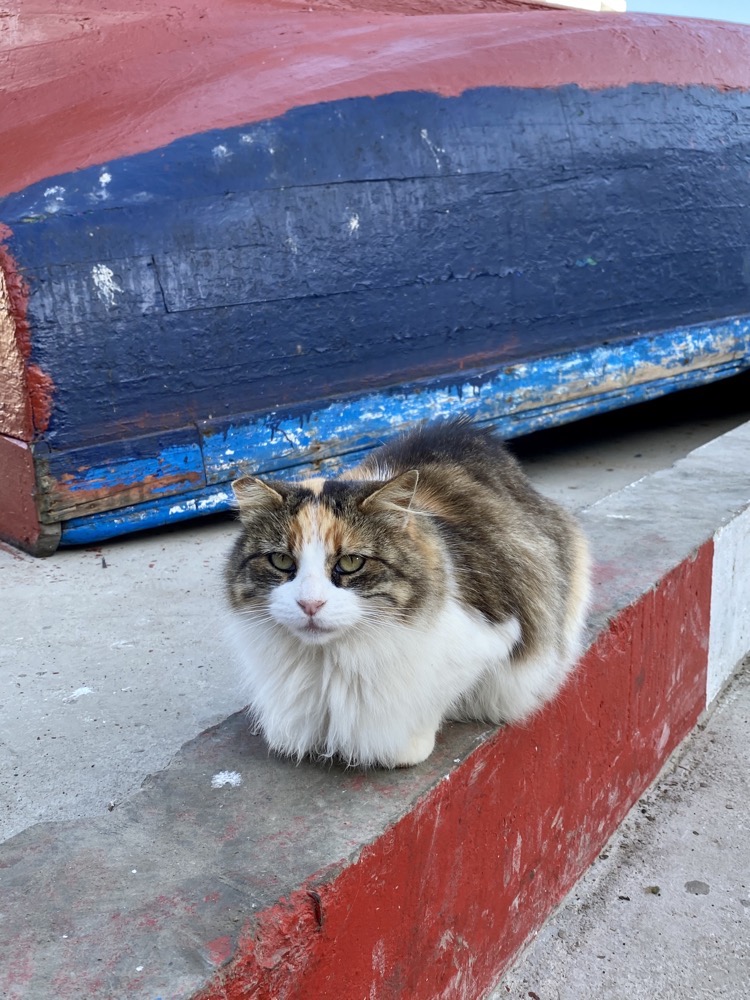


 The town’s cats don’t really belong to anyone, so the town is dotted with cute little cat houses where the cats can go to curl up out of the wind or the summer heat..
The town’s cats don’t really belong to anyone, so the town is dotted with cute little cat houses where the cats can go to curl up out of the wind or the summer heat..  The old arsenal under the fortifications is now filled with shops.
The old arsenal under the fortifications is now filled with shops. 
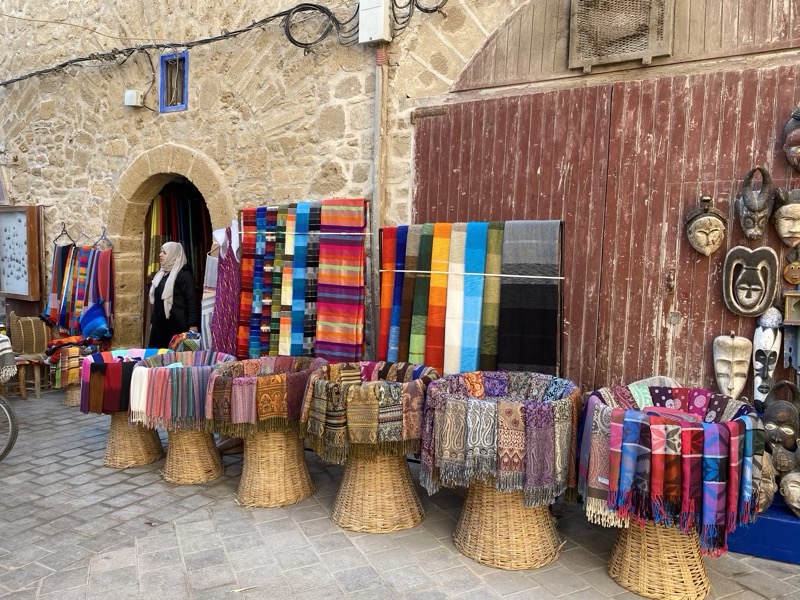 Looking up towards the battlements. The design of the fortress was such that the sounds would echo through the rounded battlements so that one or two cannon could be fired and it would sound like a dozen or more. It was a fairly effective deterrent from invaders arriving from the sea, however, if they did round the corner…
Looking up towards the battlements. The design of the fortress was such that the sounds would echo through the rounded battlements so that one or two cannon could be fired and it would sound like a dozen or more. It was a fairly effective deterrent from invaders arriving from the sea, however, if they did round the corner…  invaders would be greeted by ‘real Moroccan hospitality’, according to Rashida.
invaders would be greeted by ‘real Moroccan hospitality’, according to Rashida. 
 More fat cats – it’s hard to take photos around this area without them.
More fat cats – it’s hard to take photos around this area without them.
 Some of the canon along the battlement were made/ordered by Carlos III of Spain, others are Danish in origin
Some of the canon along the battlement were made/ordered by Carlos III of Spain, others are Danish in origin



 The medina is much like other towns we have visited, though much more relaxed and laid back. This has become a holiday town for Europeans and has a very European influence in the food, the shopping and the general atmosphere.
The medina is much like other towns we have visited, though much more relaxed and laid back. This has become a holiday town for Europeans and has a very European influence in the food, the shopping and the general atmosphere.  The next place we stopped into was the Centre Artisanal known for its extremely fine handicrafts made from the Thuya timber.
The next place we stopped into was the Centre Artisanal known for its extremely fine handicrafts made from the Thuya timber.  Thuya wood (pronounced two-ya) comes from the Thuya tree (Tetraclinis articulata) which is native only to Morocco…the lovely burled part of the timber is created from a tumour like grown that appears in the tree’s roots.
Thuya wood (pronounced two-ya) comes from the Thuya tree (Tetraclinis articulata) which is native only to Morocco…the lovely burled part of the timber is created from a tumour like grown that appears in the tree’s roots.  The local master craftsman make extremely intricate pieces which have mother of peal, lemonwood, abalone shell and charred timber (to mimic ebony) in ever-increasingly complex patterns and designs. The results are gorgeous.
The local master craftsman make extremely intricate pieces which have mother of peal, lemonwood, abalone shell and charred timber (to mimic ebony) in ever-increasingly complex patterns and designs. The results are gorgeous.

 This round table is made of three occasional tables which can be laid out in many different ways to create a zigzag long table or a round table or lotus shape or whatever. It goes for around 16000DH ((AUD$2700). Needless to say, we admired them greatly and left them in the shop!
This round table is made of three occasional tables which can be laid out in many different ways to create a zigzag long table or a round table or lotus shape or whatever. It goes for around 16000DH ((AUD$2700). Needless to say, we admired them greatly and left them in the shop! The various sellers of Thuya wood tend to claim that their industry is sustainable and they are supposed to plant two trees for every one that is cut down, but according to Rashida, the reality is somewhat different and the trees are heading towards being endangered. They take about 30 years to grow to maturity, and they live in a symbiotic relationship with the argan trees… both grow better if planted together.
The various sellers of Thuya wood tend to claim that their industry is sustainable and they are supposed to plant two trees for every one that is cut down, but according to Rashida, the reality is somewhat different and the trees are heading towards being endangered. They take about 30 years to grow to maturity, and they live in a symbiotic relationship with the argan trees… both grow better if planted together.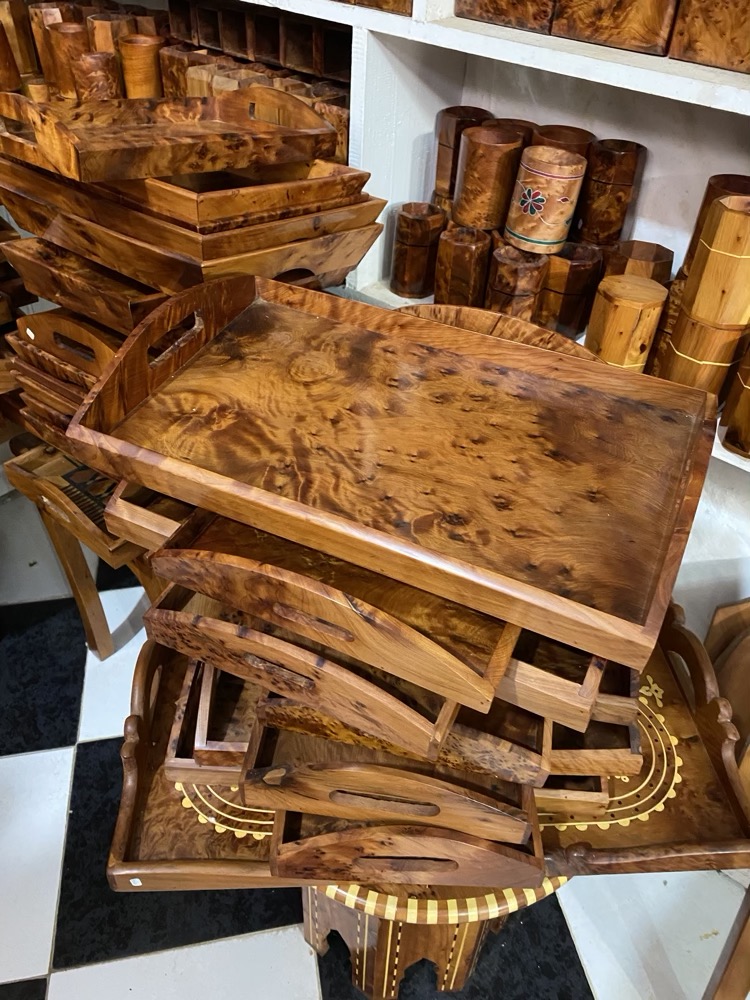
 It’s gorgeous timber, but most of the pieces are just not things I would use or need. Puzzle boxes, jewellery boxes, trays, bowls, desk accessories, chess sets, domino games and all sorts of beautiful things everywhere..
It’s gorgeous timber, but most of the pieces are just not things I would use or need. Puzzle boxes, jewellery boxes, trays, bowls, desk accessories, chess sets, domino games and all sorts of beautiful things everywhere.. 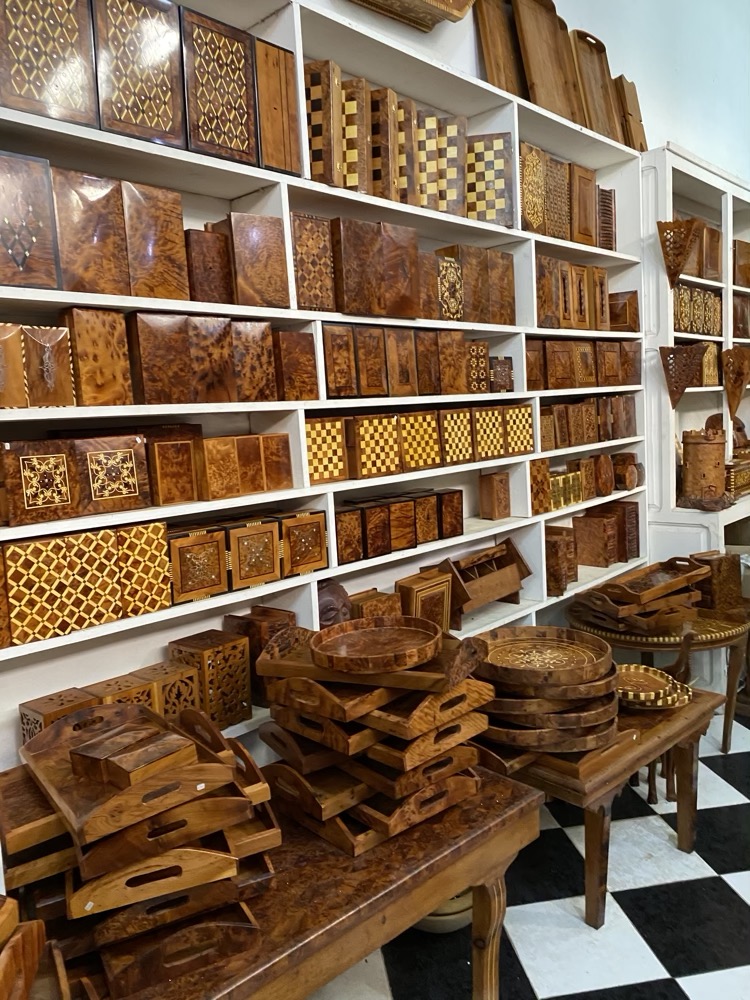
 Outside again, we were headed through the medina towards the fish markets which we expected would be relatively quiet on a Sunday.
Outside again, we were headed through the medina towards the fish markets which we expected would be relatively quiet on a Sunday.  Here, I encountered a man selling lots of traditional pigments,.. the white container with the red lid contains the royal ‘Tyrian purple’ favoured by Romans that comes from crushed sea snails – murex.
Here, I encountered a man selling lots of traditional pigments,.. the white container with the red lid contains the royal ‘Tyrian purple’ favoured by Romans that comes from crushed sea snails – murex.  Around the end of the 1stC BC, the Berber king Juba II established a Tyrian purple factory here in Essaouira, where they processed murex and purpura shells found in the rock pools in the harbour and the Iles Purpuraires. This dye was used to colour the purple stripes in the togas worn by the Senators of Imperial Rome until Caligula decreed that only Roman royalty could wear the royal purple.
Around the end of the 1stC BC, the Berber king Juba II established a Tyrian purple factory here in Essaouira, where they processed murex and purpura shells found in the rock pools in the harbour and the Iles Purpuraires. This dye was used to colour the purple stripes in the togas worn by the Senators of Imperial Rome until Caligula decreed that only Roman royalty could wear the royal purple.  The ground murex is a dark dirty green colour until mixed with water – you can see the purple colour on the edge of the container where it has come into contact with moisture from the sea air.
The ground murex is a dark dirty green colour until mixed with water – you can see the purple colour on the edge of the container where it has come into contact with moisture from the sea air. Fish markety goodness… could be any fishmarket in any country anywhere.
Fish markety goodness… could be any fishmarket in any country anywhere. 
 Next stop was to a workshop for silversmithing – this particular workshop helped deaf people get gainful employment by teaching them to do the fine silver filigree work favoured by the region’s jewellery trade.
Next stop was to a workshop for silversmithing – this particular workshop helped deaf people get gainful employment by teaching them to do the fine silver filigree work favoured by the region’s jewellery trade. 
 We were shown with a touchstone how real silver reacts to acid, and learned a little about traditional Berger designs – most of which seem to be about courtship rituals and symbols of fertility.
We were shown with a touchstone how real silver reacts to acid, and learned a little about traditional Berger designs – most of which seem to be about courtship rituals and symbols of fertility. This Celtic inspired fibular brooch has a large decorative triangular shape attached which is supposed to represent a uterus. It also indicates that a woman is ‘available’… to successfully woo the wearer, her paramour needs to find/have made a matching brooch and hook them together with a heavy silver chain.
This Celtic inspired fibular brooch has a large decorative triangular shape attached which is supposed to represent a uterus. It also indicates that a woman is ‘available’… to successfully woo the wearer, her paramour needs to find/have made a matching brooch and hook them together with a heavy silver chain. Bangles:
Bangles:
 Pendants… oh so many pendants.
Pendants… oh so many pendants.
 After we checked out the lovely silverwork, we had some quiet time to talk to Rashida about the life of women in Morocco. We had been asking Samirr, ‘Why do we only see men in the shops? How come our hosts in the guesthouses are always men? Where are the women, and can we talk to them?’ A few of us really wanted to talk to an educated woman (someone with good English) who might be prepared to have a frank discussion with us about what it’s like being a woman in an (admittedly fairly progressive) Islamic state.
After we checked out the lovely silverwork, we had some quiet time to talk to Rashida about the life of women in Morocco. We had been asking Samirr, ‘Why do we only see men in the shops? How come our hosts in the guesthouses are always men? Where are the women, and can we talk to them?’ A few of us really wanted to talk to an educated woman (someone with good English) who might be prepared to have a frank discussion with us about what it’s like being a woman in an (admittedly fairly progressive) Islamic state.
The dot points of that conversation went somewhat as follows:
– Morocco has 38% illiteracy, but if you count just the women, that nearly doubles to 65%+
– Most women don’t get an opportunity for education at all, even now, so Rashida being born in the early 70s and university-educated is quite the anomaly – she was sent to school to learn ‘not to be a tomboy’ because she had five older brothers (only three surviving).
– Girls and women are usually ‘kept inside’ from the time of menstruation, so as not to attract the attention of men.
– Arranged marriages are still common, but now women need to appear in court and demonstrate they consent to the marriage (which may or may not be genuine consent).
– The legal age for marriage for girls was increased from 16 to 18 only in 2004, but child marriage still remains quite a problem, especially in rural areas.
– Women have only recently been given the right to divorce their husbands, but men have been able to cast off unwanted wives forever.
– A man can still have three or four wives, but he needs written consent from his existing wives before marrying again… there is literally no mechanism to stop this consent being coerced from the existing wives.
– A widow may remarry but no one would want her as she has been ‘taken and used’ by another man. A man prefers a virginal woman only, so widows tend to remain alone.
– If a woman is raped, her family is likely to offer her as a bride to her rapist. Once ‘used’ she is effectively damaged goods, and no ‘proper family or proper man’ would want her after that. So the only options are to charge the rapist and try to see him sent to jail, or to marry the victim to her rapist so that he might ‘make her respectable’ in the eyes of the village. (Rashida told us a story of an incidence of this occurring to a young 16-year-old victim only 3 years ago, the young girl involved was forced to marry her attacker and unsurprisingly about three or four months later, she committed suicide rather than stay with her ‘husband’ who now had state sanction to keep raping her.
– Children born out of wedlock used to bear their mother’s name either, so the children grew up with the stain of the mother’s sin (or attack) forever. Now they are required to bear the father’s name regardless of the circumstance surrounding their conception, and they have rights to inheritance and upkeep.
– Children automatically stay with their mothers until the age of 12 in the case of a divorce, but the fathers have as much access to their children as they desire – there are no custody battles, the father’s rights supersede the mother’s wishes.
– Domestic abuse is rife, and rarely, if ever, reported.
– Likewise, child abuse and child sexual abuse is never reported – partly because of the stigma and partly because education is so poor, most children are not aware of what is ‘proper’ behaviour from adults, so cases won’t come to light until an abused child has grown up.
– All male children here are circumcised for religious (Jewish) or hygiene reasons, but Morocco never practised female circumcision, ‘that is an African practise, not an Islamic one’.
– Honour killings are rare but unfortunately do still happen in Moroccan Islamic communities.
All up, our half-hour chat with Rashida was very interesting. She was open and frank about her culture as well as her own personal experiences – she is married to a man who had four children from a previous marriage, but was unable to have any children of her own. She is pretty much my age, but already has a handful of step-grandchildren. We were very grateful to have an opportunity to have a talk with her and gain an understanding of the challenges that women face in Morocco… her general feeling is that things are improving, but it’s taking time, and that education and healthcare are the keys to speeding up that process of improvement.
After our chat with Rashida, I met back up with Mr K and we found ourselves a little rooftop terrace for a light lunch. We spent the afternoon doing a bit of shopping and exploring the medina. It wasn’t as busy as we thought the area might be on a Sunday, and we had a much more laid back and friendly shopping experience than we did in Marrakech or Fez.  Back at the riad, we ended up having drinks on the rooftop to finally try and get rid of the excess beers that Mohammed had bought for us, and then it was off for a slightly tipsy stumble into the medina to find a restaurant for a light dinner.
Back at the riad, we ended up having drinks on the rooftop to finally try and get rid of the excess beers that Mohammed had bought for us, and then it was off for a slightly tipsy stumble into the medina to find a restaurant for a light dinner.  We have most of the day here tomorrow too, but other than a few last souvenir type errands, we don’t have any plans other than to finally spend a few hours of this vacation chilling (or catching up on backlog of work that is creeping up on us!). Tomorrow, we transit back to Marrakech for the last two days of our trip.
We have most of the day here tomorrow too, but other than a few last souvenir type errands, we don’t have any plans other than to finally spend a few hours of this vacation chilling (or catching up on backlog of work that is creeping up on us!). Tomorrow, we transit back to Marrakech for the last two days of our trip.
 Gone was the soundstage with the makeshift concert venue set up for 40,000 people, gone were most of the snake charmers, monkey handlers, watermen, spruikers, and the heaving tide of humanity that we pushed through when we were here last. The place was just eeriely quiet. This is 10am on a Tuesday in Marrakech’s main square!
Gone was the soundstage with the makeshift concert venue set up for 40,000 people, gone were most of the snake charmers, monkey handlers, watermen, spruikers, and the heaving tide of humanity that we pushed through when we were here last. The place was just eeriely quiet. This is 10am on a Tuesday in Marrakech’s main square!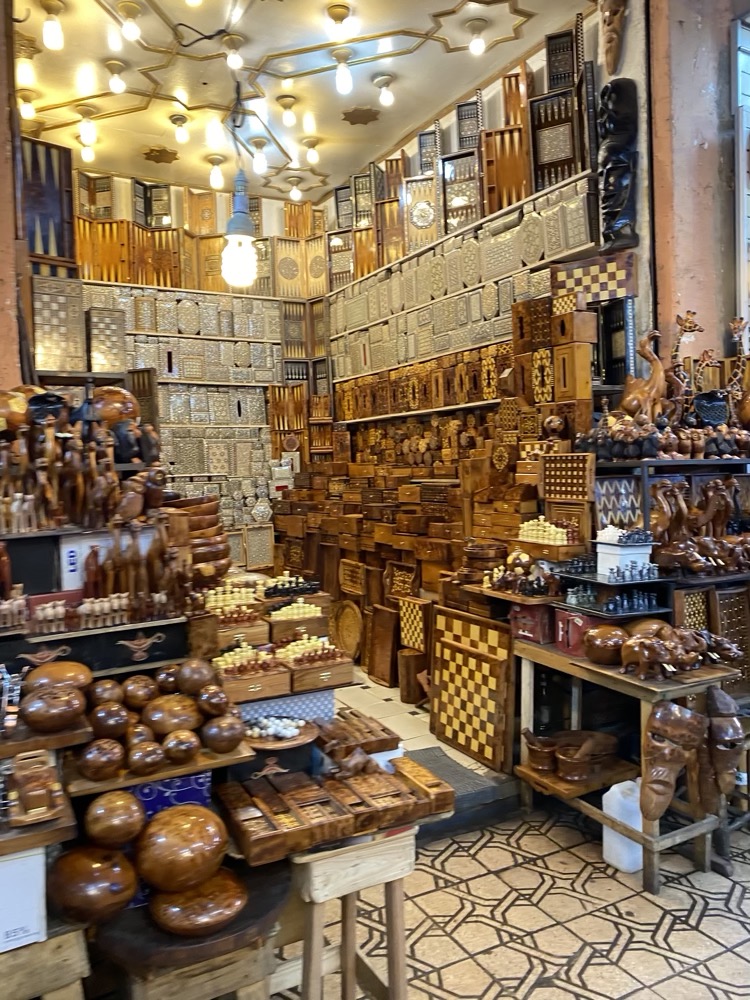

 Literally, shop after shop, empty.
Literally, shop after shop, empty.
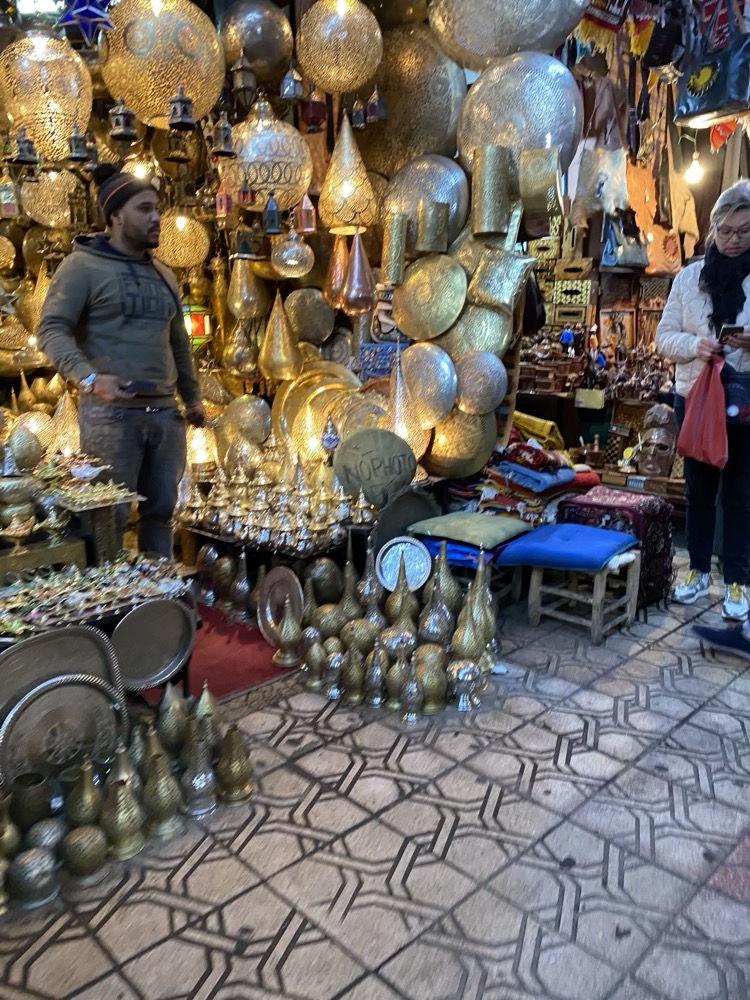
 Guess what Dr Nick? I have made it through three weeks in Morocco surrounded by gorgeous pashmina and haven’t bought a single one! Not even under the pretence that it’s a gift for someone else… who would have thought such a thing could ever happen! 🙂
Guess what Dr Nick? I have made it through three weeks in Morocco surrounded by gorgeous pashmina and haven’t bought a single one! Not even under the pretence that it’s a gift for someone else… who would have thought such a thing could ever happen! 🙂  After our rather quiet (and I have to admit, pleasant) trip into the medina, we went to pick up some laundry and do a few errands before it was back to the hotel to play Tetris with the luggage – that’s always my job. Making it all fit in. We normally make sure we don’t buy things that need to be declared when coming back into Australia – it always just reeks of too much effort when you’re shattered from the long haul, but the handicrafts here have defeated us and we have several things that need to be declared, so I have carefully packed those for easy access at customs.
After our rather quiet (and I have to admit, pleasant) trip into the medina, we went to pick up some laundry and do a few errands before it was back to the hotel to play Tetris with the luggage – that’s always my job. Making it all fit in. We normally make sure we don’t buy things that need to be declared when coming back into Australia – it always just reeks of too much effort when you’re shattered from the long haul, but the handicrafts here have defeated us and we have several things that need to be declared, so I have carefully packed those for easy access at customs. Spent the afternoon getting some work underway and packing. After that, though, we were too stuffed to go out to hunt and gather for food. So this is what we ordered from room service at our hotel – a Scillian pizza (with way too much capsicum and missing the requested anchovies), a kefta tagine (which was very tasty) and some Moroccan goats cheese and herb briouats (little filo pastry pies). It was extremely tasty.
Spent the afternoon getting some work underway and packing. After that, though, we were too stuffed to go out to hunt and gather for food. So this is what we ordered from room service at our hotel – a Scillian pizza (with way too much capsicum and missing the requested anchovies), a kefta tagine (which was very tasty) and some Moroccan goats cheese and herb briouats (little filo pastry pies). It was extremely tasty. After this, we managed to find a movie on the TV, (‘Man on a Ledge’, in English) and aimed for an early night. So much for that! Woke up at 04:17 and haven’t been able to get back to sleep which seriously sucks when I am facing a 24hr+ transit starting around 11:00. :/
After this, we managed to find a movie on the TV, (‘Man on a Ledge’, in English) and aimed for an early night. So much for that! Woke up at 04:17 and haven’t been able to get back to sleep which seriously sucks when I am facing a 24hr+ transit starting around 11:00. :/
 Our first port of call on our walking tour (pun intended) was the harbour where much of the local fishing industry is carried out.
Our first port of call on our walking tour (pun intended) was the harbour where much of the local fishing industry is carried out. 
 Local fishermen will bring in their catch here and a bustling and busy wholesale fish auction occur every morning – except this morning, which is Sunday. Historically, Essaouira has been occupied since prehistoric times as the bay is fairly adequately protected by Mogador Island, which makes it a very peaceful and protected harbour from the strong Atlantic winds.
Local fishermen will bring in their catch here and a bustling and busy wholesale fish auction occur every morning – except this morning, which is Sunday. Historically, Essaouira has been occupied since prehistoric times as the bay is fairly adequately protected by Mogador Island, which makes it a very peaceful and protected harbour from the strong Atlantic winds.

 In the 16thC, Essaouira was occupied by Portugal, ad the King at the time, Manuel I ordered a fortress to be built here – it was called the Castelo Real de Mogador – Essaouira was known as Mogador up until the 1960s. By that time, the Portuguese had control of six Moroccan coastal towns and had built a stand-alone fortress in each town from the start of their occupation in the mid 15thC Most of them were short-lived, being only held for between 5-25 years… by 1541, the fortress at Agadir had fallen to the Saardians (that was the Arab-Moroccan dynasty that ruled Morocco from 1549-1659) and the Portuguese had to abandon all the settlements they had occupied managing only to hold onto Tangier, Cuta and Mazagan.
In the 16thC, Essaouira was occupied by Portugal, ad the King at the time, Manuel I ordered a fortress to be built here – it was called the Castelo Real de Mogador – Essaouira was known as Mogador up until the 1960s. By that time, the Portuguese had control of six Moroccan coastal towns and had built a stand-alone fortress in each town from the start of their occupation in the mid 15thC Most of them were short-lived, being only held for between 5-25 years… by 1541, the fortress at Agadir had fallen to the Saardians (that was the Arab-Moroccan dynasty that ruled Morocco from 1549-1659) and the Portuguese had to abandon all the settlements they had occupied managing only to hold onto Tangier, Cuta and Mazagan.


 Various parts of the fortifications were built and extended on from that time onwards. The present fortifications were built in the 1700s by various French architects – Rashida tells us Moroccans know how to build things, but are not very good at maintaining them.
Various parts of the fortifications were built and extended on from that time onwards. The present fortifications were built in the 1700s by various French architects – Rashida tells us Moroccans know how to build things, but are not very good at maintaining them.  The triumphal arch that joins the harbour to the fortifications represents several different religions that coexisted in the town at that time – the pilgrim’s Shell of Santiago was for the Christians, particularly Spanish Catholics, below it is a Koranic verse along with an Islamic date of 1184, and further below that are crescents for the ‘fertile moon’ which lies between the Tigress and the Euphrates, and if you look closely there are some small stars of David in the flowers on the lozenge motifs. Essaouira had a large Jewish population here, and they were never persecuted like they were in Europe. It was the only safe haven the Jewish had ever known – however on the formation of Israel after WWII 98% of Essaouira’s Jewish population moved to Israel, leaving only about 40-50 Jewish families here now.
The triumphal arch that joins the harbour to the fortifications represents several different religions that coexisted in the town at that time – the pilgrim’s Shell of Santiago was for the Christians, particularly Spanish Catholics, below it is a Koranic verse along with an Islamic date of 1184, and further below that are crescents for the ‘fertile moon’ which lies between the Tigress and the Euphrates, and if you look closely there are some small stars of David in the flowers on the lozenge motifs. Essaouira had a large Jewish population here, and they were never persecuted like they were in Europe. It was the only safe haven the Jewish had ever known – however on the formation of Israel after WWII 98% of Essaouira’s Jewish population moved to Israel, leaving only about 40-50 Jewish families here now. There is an enormous number of cats in this town – they are all very well fed and very well looked after as they keep down the rat population. Essaouira never suffered from the plague due to their harmonious relationship with cats. Here, they collect the cats and desex them, give them shots and keep them healthy – they then dock the cat’s ear. so the community knows they should feed and look after that cat. Cats without their ear docked are to be avoided as they might be diseased. With the rabies.
There is an enormous number of cats in this town – they are all very well fed and very well looked after as they keep down the rat population. Essaouira never suffered from the plague due to their harmonious relationship with cats. Here, they collect the cats and desex them, give them shots and keep them healthy – they then dock the cat’s ear. so the community knows they should feed and look after that cat. Cats without their ear docked are to be avoided as they might be diseased. With the rabies. 


 The town’s cats don’t really belong to anyone, so the town is dotted with cute little cat houses where the cats can go to curl up out of the wind or the summer heat..
The town’s cats don’t really belong to anyone, so the town is dotted with cute little cat houses where the cats can go to curl up out of the wind or the summer heat..  The old arsenal under the fortifications is now filled with shops.
The old arsenal under the fortifications is now filled with shops. 
 Looking up towards the battlements. The design of the fortress was such that the sounds would echo through the rounded battlements so that one or two cannon could be fired and it would sound like a dozen or more. It was a fairly effective deterrent from invaders arriving from the sea, however, if they did round the corner…
Looking up towards the battlements. The design of the fortress was such that the sounds would echo through the rounded battlements so that one or two cannon could be fired and it would sound like a dozen or more. It was a fairly effective deterrent from invaders arriving from the sea, however, if they did round the corner…  invaders would be greeted by ‘real Moroccan hospitality’, according to Rashida.
invaders would be greeted by ‘real Moroccan hospitality’, according to Rashida. 
 More fat cats – it’s hard to take photos around this area without them.
More fat cats – it’s hard to take photos around this area without them.
 Some of the canon along the battlement were made/ordered by Carlos III of Spain, others are Danish in origin
Some of the canon along the battlement were made/ordered by Carlos III of Spain, others are Danish in origin



 The medina is much like other towns we have visited, though much more relaxed and laid back. This has become a holiday town for Europeans and has a very European influence in the food, the shopping and the general atmosphere.
The medina is much like other towns we have visited, though much more relaxed and laid back. This has become a holiday town for Europeans and has a very European influence in the food, the shopping and the general atmosphere.  The next place we stopped into was the Centre Artisanal known for its extremely fine handicrafts made from the Thuya timber.
The next place we stopped into was the Centre Artisanal known for its extremely fine handicrafts made from the Thuya timber.  Thuya wood (pronounced two-ya) comes from the Thuya tree (Tetraclinis articulata) which is native only to Morocco…the lovely burled part of the timber is created from a tumour like grown that appears in the tree’s roots.
Thuya wood (pronounced two-ya) comes from the Thuya tree (Tetraclinis articulata) which is native only to Morocco…the lovely burled part of the timber is created from a tumour like grown that appears in the tree’s roots.  The local master craftsman make extremely intricate pieces which have mother of peal, lemonwood, abalone shell and charred timber (to mimic ebony) in ever-increasingly complex patterns and designs. The results are gorgeous.
The local master craftsman make extremely intricate pieces which have mother of peal, lemonwood, abalone shell and charred timber (to mimic ebony) in ever-increasingly complex patterns and designs. The results are gorgeous.

 This round table is made of three occasional tables which can be laid out in many different ways to create a zigzag long table or a round table or lotus shape or whatever. It goes for around 16000DH ((AUD$2700). Needless to say, we admired them greatly and left them in the shop!
This round table is made of three occasional tables which can be laid out in many different ways to create a zigzag long table or a round table or lotus shape or whatever. It goes for around 16000DH ((AUD$2700). Needless to say, we admired them greatly and left them in the shop! The various sellers of Thuya wood tend to claim that their industry is sustainable and they are supposed to plant two trees for every one that is cut down, but according to Rashida, the reality is somewhat different and the trees are heading towards being endangered. They take about 30 years to grow to maturity, and they live in a symbiotic relationship with the argan trees… both grow better if planted together.
The various sellers of Thuya wood tend to claim that their industry is sustainable and they are supposed to plant two trees for every one that is cut down, but according to Rashida, the reality is somewhat different and the trees are heading towards being endangered. They take about 30 years to grow to maturity, and they live in a symbiotic relationship with the argan trees… both grow better if planted together.
 It’s gorgeous timber, but most of the pieces are just not things I would use or need. Puzzle boxes, jewellery boxes, trays, bowls, desk accessories, chess sets, domino games and all sorts of beautiful things everywhere..
It’s gorgeous timber, but most of the pieces are just not things I would use or need. Puzzle boxes, jewellery boxes, trays, bowls, desk accessories, chess sets, domino games and all sorts of beautiful things everywhere.. 
 Outside again, we were headed through the medina towards the fish markets which we expected would be relatively quiet on a Sunday.
Outside again, we were headed through the medina towards the fish markets which we expected would be relatively quiet on a Sunday.  Here, I encountered a man selling lots of traditional pigments,.. the white container with the red lid contains the royal ‘Tyrian purple’ favoured by Romans that comes from crushed sea snails – murex.
Here, I encountered a man selling lots of traditional pigments,.. the white container with the red lid contains the royal ‘Tyrian purple’ favoured by Romans that comes from crushed sea snails – murex.  Around the end of the 1stC BC, the Berber king Juba II established a
Around the end of the 1stC BC, the Berber king Juba II established a  The ground murex is a dark dirty green colour until mixed with water – you can see the purple colour on the edge of the container where it has come into contact with moisture from the sea air.
The ground murex is a dark dirty green colour until mixed with water – you can see the purple colour on the edge of the container where it has come into contact with moisture from the sea air. Fish markety goodness… could be any fishmarket in any country anywhere.
Fish markety goodness… could be any fishmarket in any country anywhere. 
 Next stop was to a workshop for silversmithing – this particular workshop helped deaf people get gainful employment by teaching them to do the fine silver filigree work favoured by the region’s jewellery trade.
Next stop was to a workshop for silversmithing – this particular workshop helped deaf people get gainful employment by teaching them to do the fine silver filigree work favoured by the region’s jewellery trade. 
 We were shown with a touchstone how real silver reacts to acid, and learned a little about traditional Berger designs – most of which seem to be about courtship rituals and symbols of fertility.
We were shown with a touchstone how real silver reacts to acid, and learned a little about traditional Berger designs – most of which seem to be about courtship rituals and symbols of fertility. This Celtic inspired fibular brooch has a large decorative triangular shape attached which is supposed to represent a uterus. It also indicates that a woman is ‘available’… to successfully woo the wearer, her paramour needs to find/have made a matching brooch and hook them together with a heavy silver chain.
This Celtic inspired fibular brooch has a large decorative triangular shape attached which is supposed to represent a uterus. It also indicates that a woman is ‘available’… to successfully woo the wearer, her paramour needs to find/have made a matching brooch and hook them together with a heavy silver chain. Bangles:
Bangles: Pendants… oh so many pendants.
Pendants… oh so many pendants.
 After we checked out the lovely silverwork, we had some quiet time to talk to Rashida about the life of women in Morocco. We had been asking Samirr, ‘Why do we only see men in the shops? How come our hosts in the guesthouses are always men? Where are the women, and can we talk to them?’ A few of us really wanted to talk to an educated woman (someone with good English) who might be prepared to have a frank discussion with us about what it’s like being a woman in an (admittedly fairly progressive) Islamic state.
After we checked out the lovely silverwork, we had some quiet time to talk to Rashida about the life of women in Morocco. We had been asking Samirr, ‘Why do we only see men in the shops? How come our hosts in the guesthouses are always men? Where are the women, and can we talk to them?’ A few of us really wanted to talk to an educated woman (someone with good English) who might be prepared to have a frank discussion with us about what it’s like being a woman in an (admittedly fairly progressive) Islamic state. Back at the riad, we ended up having drinks on the rooftop to finally try and get rid of the excess beers that Mohammed had bought for us, and then it was off for a slightly tipsy stumble into the medina to find a restaurant for a light dinner.
Back at the riad, we ended up having drinks on the rooftop to finally try and get rid of the excess beers that Mohammed had bought for us, and then it was off for a slightly tipsy stumble into the medina to find a restaurant for a light dinner.  We have most of the day here tomorrow too, but other than a few last souvenir type errands, we don’t have any plans other than to finally spend a few hours of this vacation chilling (or catching up on backlog of work that is creeping up on us!). Tomorrow, we transit back to Marrakech for the last two days of our trip.
We have most of the day here tomorrow too, but other than a few last souvenir type errands, we don’t have any plans other than to finally spend a few hours of this vacation chilling (or catching up on backlog of work that is creeping up on us!). Tomorrow, we transit back to Marrakech for the last two days of our trip. Maybe Australian needs more camels on their beaches…
Maybe Australian needs more camels on their beaches… Our next stop to break up the drive north was at a women’s co-operative that makes argan oil products from the nuts of the argan tree. This very professional and (deliberately) clinical looking lady showed us how the ladies broke apart the stones from the fruti of the argan trees to get the kernels out to grind into a thick brown paste.
Our next stop to break up the drive north was at a women’s co-operative that makes argan oil products from the nuts of the argan tree. This very professional and (deliberately) clinical looking lady showed us how the ladies broke apart the stones from the fruti of the argan trees to get the kernels out to grind into a thick brown paste. 

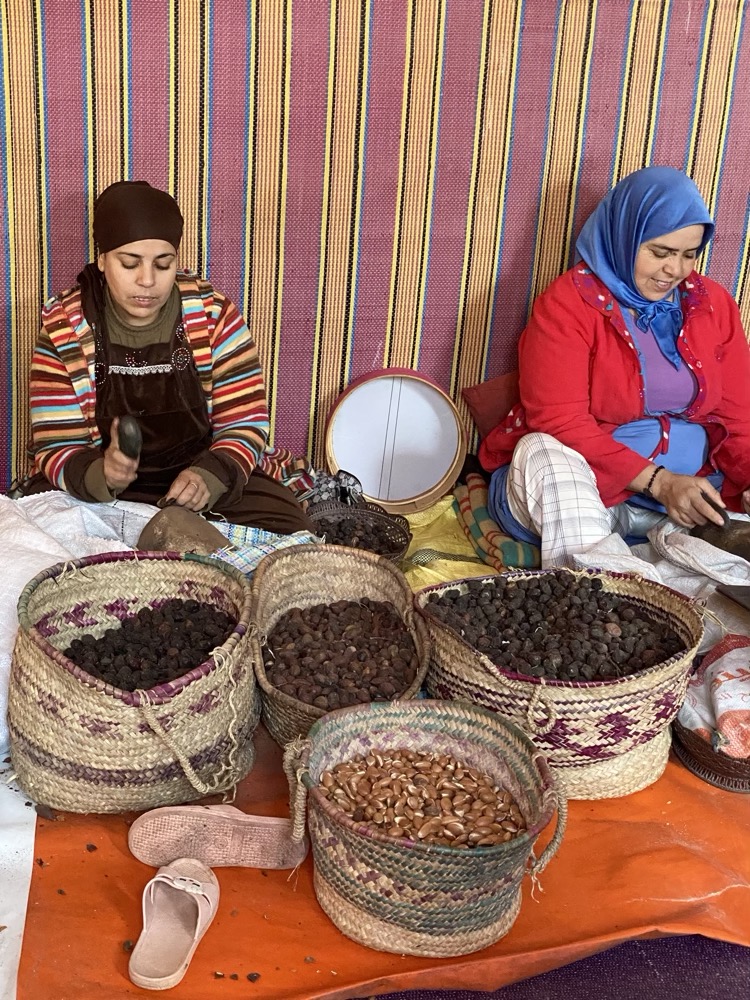
 From these kernels, they make various edible products – a cooking/dipping oil, a argain oil paste (which tastes something liek a cross between peanut butter and nutella; as well as a large range of cosmetics.
From these kernels, they make various edible products – a cooking/dipping oil, a argain oil paste (which tastes something liek a cross between peanut butter and nutella; as well as a large range of cosmetics. The argan oil comes only from Morocco and is said to have amazing anti-ageing properties, as well as being fantastic for your hair and nails and cracked heels and all of it.
The argan oil comes only from Morocco and is said to have amazing anti-ageing properties, as well as being fantastic for your hair and nails and cracked heels and all of it. 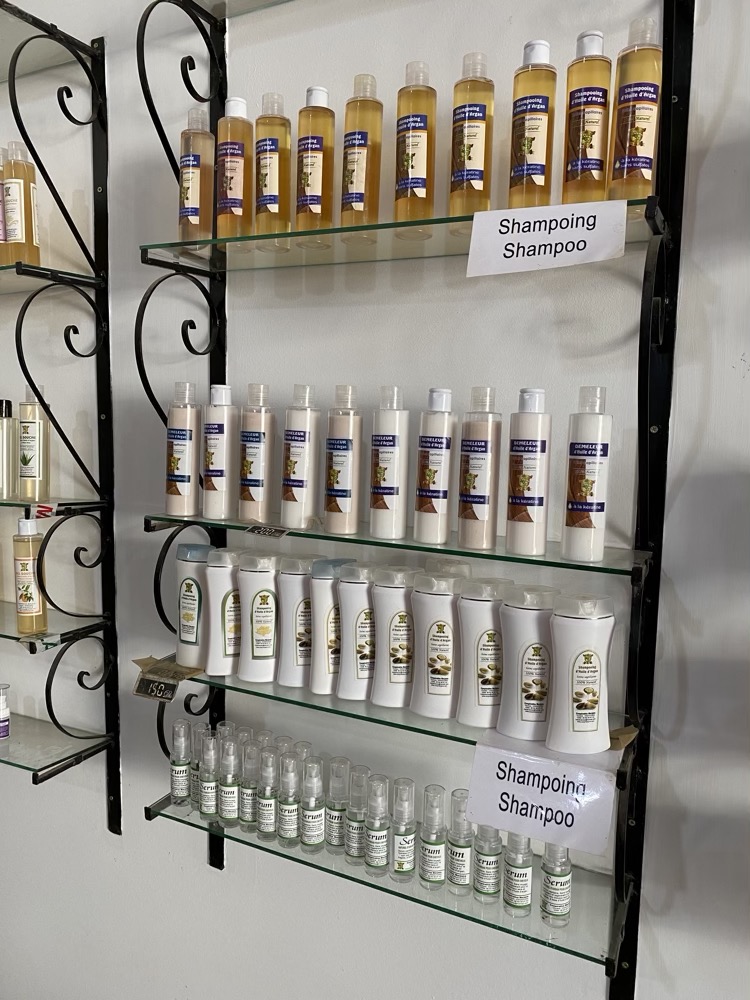 Weirdly, at home, you see lots of Moroccan coconut oil shampoos and conditions lining the shelves of supermarkets. This appears to be a totally fabricated thing. Morocco is not known for its coconut industry – their palms are predominantly date palms and their primary cosmetic oil is argan – which tends towards being very expensive back home. Oh well, consumers are always suckers for a good marketing campaign. I picked up a small bottle of leave in conditioning hair treatment, and I’m kinda hoping I don’t love it, because buying more is going to be a real bitch!
Weirdly, at home, you see lots of Moroccan coconut oil shampoos and conditions lining the shelves of supermarkets. This appears to be a totally fabricated thing. Morocco is not known for its coconut industry – their palms are predominantly date palms and their primary cosmetic oil is argan – which tends towards being very expensive back home. Oh well, consumers are always suckers for a good marketing campaign. I picked up a small bottle of leave in conditioning hair treatment, and I’m kinda hoping I don’t love it, because buying more is going to be a real bitch!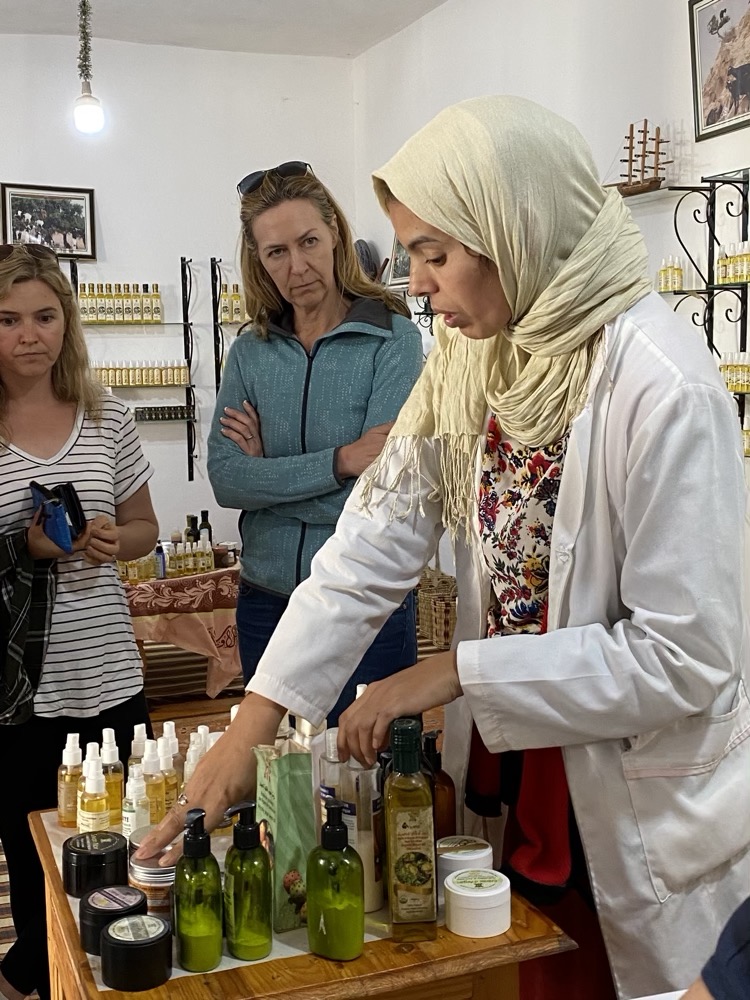 Eventually, we reached our destination for the next two nights- Essaouira, which on the Atlantic on Morocco’s west coast. It’s a very popular tourist destination with Europeans, who largely come here for the beaches, fishing, kitesurfing, and other summer holiday stuff. Until the 1960s, Essaouira was generally known by its Portuguese name, Mogador, which we have seen written all over the places still.
Eventually, we reached our destination for the next two nights- Essaouira, which on the Atlantic on Morocco’s west coast. It’s a very popular tourist destination with Europeans, who largely come here for the beaches, fishing, kitesurfing, and other summer holiday stuff. Until the 1960s, Essaouira was generally known by its Portuguese name, Mogador, which we have seen written all over the places still.  The ramparts of the medina were built in the 1700s. There was a Roman settlement here, this area is where the Tyrian purple dye used to come from that was used to dye the robes of Roman senators. It has been inhabited ever since and was occupied by the Portuguese in the middle ages.
The ramparts of the medina were built in the 1700s. There was a Roman settlement here, this area is where the Tyrian purple dye used to come from that was used to dye the robes of Roman senators. It has been inhabited ever since and was occupied by the Portuguese in the middle ages. The medina is wide and airy compared to Fez or Marrakech – and is largely for pedestrian traffic only which is nice after the hectic and chaotic environments there. Mostly, the medina is filled with Riads (we are staying right in the medina), restaurants, art galleries and handicraft shops… it feels like the Montville or Leura of Morocco!.
The medina is wide and airy compared to Fez or Marrakech – and is largely for pedestrian traffic only which is nice after the hectic and chaotic environments there. Mostly, the medina is filled with Riads (we are staying right in the medina), restaurants, art galleries and handicraft shops… it feels like the Montville or Leura of Morocco!. 


 We checked into our lovely Riad with a gorgeous little courtyard in the centre and then headed straight to the rooftop terrace to have a few beers – this was a complete necessity at this point..
We checked into our lovely Riad with a gorgeous little courtyard in the centre and then headed straight to the rooftop terrace to have a few beers – this was a complete necessity at this point..

 For you see, we had had the most fortuitous miscommunication with Mohammed, the driver of our minibus who has been with us since we left Marrakech. Samirr had arranged for Mohammed to go buy us some alcohol to take to the desert camp, and each person wrote down what they wanted and we were to pay him when he came back. And, being all Aussies, Kiwis, Canadians and Americans we wrote things down like ‘one six-pack’ and ‘one bottle of red wine’ (with a price range). We didn’t have high hopes on Mohammed’s ability to choose a nice red – but we didn’t expect him to some how mistake a ‘six-pack’ with a slab… so somehow instead of five six packs turning up to have a few quiet ones at the Sahara camp, we had five cartons turn up!
For you see, we had had the most fortuitous miscommunication with Mohammed, the driver of our minibus who has been with us since we left Marrakech. Samirr had arranged for Mohammed to go buy us some alcohol to take to the desert camp, and each person wrote down what they wanted and we were to pay him when he came back. And, being all Aussies, Kiwis, Canadians and Americans we wrote things down like ‘one six-pack’ and ‘one bottle of red wine’ (with a price range). We didn’t have high hopes on Mohammed’s ability to choose a nice red – but we didn’t expect him to some how mistake a ‘six-pack’ with a slab… so somehow instead of five six packs turning up to have a few quiet ones at the Sahara camp, we had five cartons turn up!
 After a few drinks and a bit of a wind-down, we went for a short stroll into the medina to find some dinner. We all tended towards different fare for the evening and Mr K and I ended up in a very quiet and secluded seafood restaurant enjoying a really nice predominantly European menu with local fresh fish – avocado, shrimp and crab entree, some weird goat cheese spring roll which was absolutely delicious, some grilled john dory fillets and an extremely rich lemon creme brulee (probably the richest thing I’ve eaten in three weeks… only managed about half).
After a few drinks and a bit of a wind-down, we went for a short stroll into the medina to find some dinner. We all tended towards different fare for the evening and Mr K and I ended up in a very quiet and secluded seafood restaurant enjoying a really nice predominantly European menu with local fresh fish – avocado, shrimp and crab entree, some weird goat cheese spring roll which was absolutely delicious, some grilled john dory fillets and an extremely rich lemon creme brulee (probably the richest thing I’ve eaten in three weeks… only managed about half). Then back to the Riad, a hot shower and crashed. So tired from a couple of long days on the bus! We have all day in town tomorrow to have a really good look around, I’m currently trying to decide whether to go get a massage or find the local museum to see if they have any interesting Roman objects in their collection.
Then back to the Riad, a hot shower and crashed. So tired from a couple of long days on the bus! We have all day in town tomorrow to have a really good look around, I’m currently trying to decide whether to go get a massage or find the local museum to see if they have any interesting Roman objects in their collection. We started out day off this morning with a spot of rug shopping at a local women’s weaving cooperative. The Berber style of rugs prevalent throughout Morocco is quite distinctive. They’re very busy and have a lot of motifs (many of which are for good luck or fertility) that repeat through the patterns. They’re also really asymmetrical compared to other hand made rugs that you usually see coming out of Eurasia and the Middle East.
We started out day off this morning with a spot of rug shopping at a local women’s weaving cooperative. The Berber style of rugs prevalent throughout Morocco is quite distinctive. They’re very busy and have a lot of motifs (many of which are for good luck or fertility) that repeat through the patterns. They’re also really asymmetrical compared to other hand made rugs that you usually see coming out of Eurasia and the Middle East.  The boys looked very exciting for their second foray into Berber home furnishings.
The boys looked very exciting for their second foray into Berber home furnishings.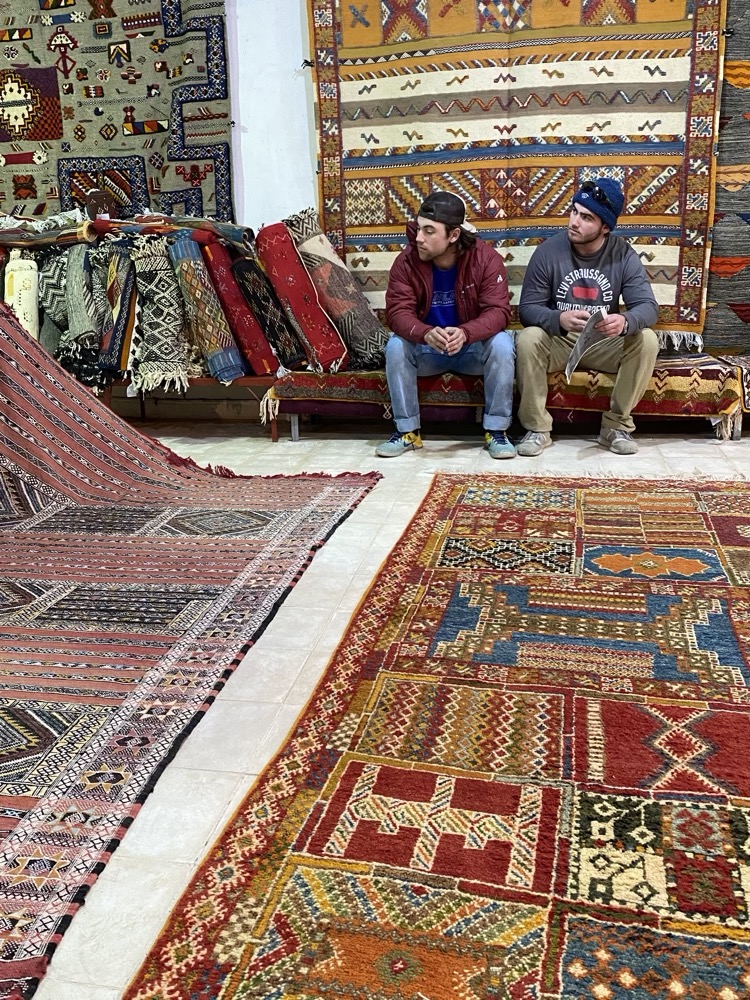 Our hosts laid out about 100 rugs for our viewing pleasure… some of them gorgeous, some of them downright hard on the eyes. We seemed to have an extraordinary shopping experience this morning. These rugs actually had prices on them, which is unusual in places where you expect to barter (ie: where they really truly want to fleece the tourists good and proper), and the marked prices were quite reasonable compared to what we had seen in other rug shops in the various medinas.
Our hosts laid out about 100 rugs for our viewing pleasure… some of them gorgeous, some of them downright hard on the eyes. We seemed to have an extraordinary shopping experience this morning. These rugs actually had prices on them, which is unusual in places where you expect to barter (ie: where they really truly want to fleece the tourists good and proper), and the marked prices were quite reasonable compared to what we had seen in other rug shops in the various medinas. Mr K getting worried for his wallet…
Mr K getting worried for his wallet…

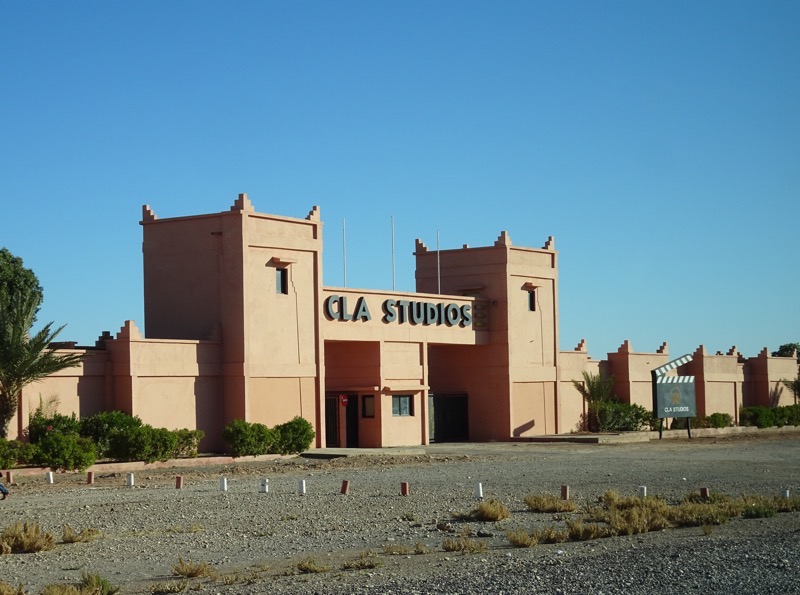
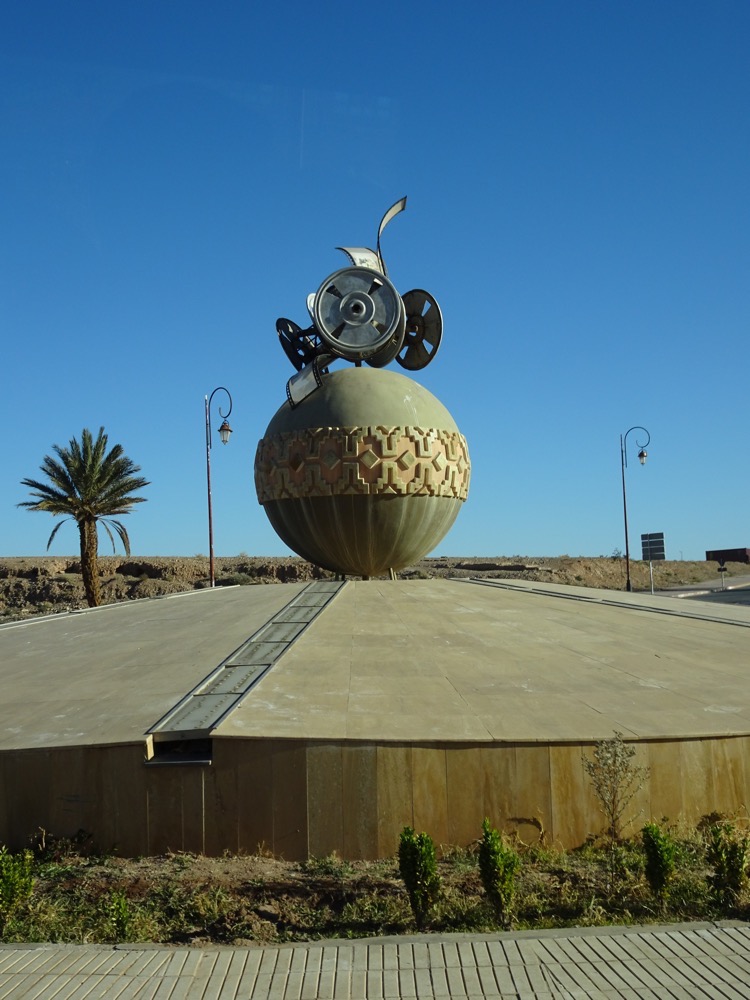 Very quickly though we were into the mountains again and into the pass. Unlike the terrain around Aroumd which was formed by glaciers, this entire area was formed by volcanic actions however many millions of years ago. You can see the swirling layers of rock that form the desert. It’s so dry here and barely a tree in sight.
Very quickly though we were into the mountains again and into the pass. Unlike the terrain around Aroumd which was formed by glaciers, this entire area was formed by volcanic actions however many millions of years ago. You can see the swirling layers of rock that form the desert. It’s so dry here and barely a tree in sight.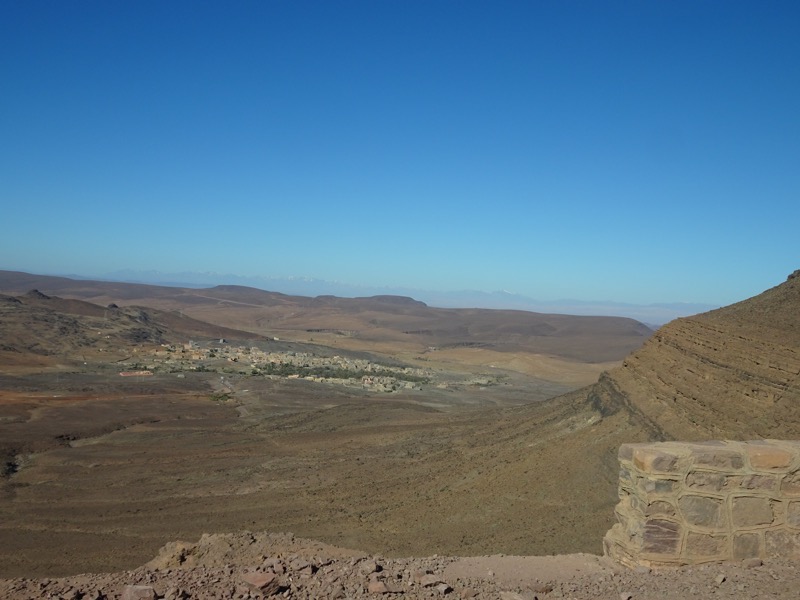 It beggars belief as to why you would bulid here, but there are the Berber people who live in these walled towns, and Bedouin and nomadic people who used to raid them all fighting for resources in the region. Each little town has a kasbah or fortress which can be retreated to when the nomads or Bedouins come invading…?
It beggars belief as to why you would bulid here, but there are the Berber people who live in these walled towns, and Bedouin and nomadic people who used to raid them all fighting for resources in the region. Each little town has a kasbah or fortress which can be retreated to when the nomads or Bedouins come invading…? The scenery was really impessive, enormous rocky canyons, and steep cliffs as we approced the mountain pass which was 1800m above sea level (much lower than Aroumd at 2640m).
The scenery was really impessive, enormous rocky canyons, and steep cliffs as we approced the mountain pass which was 1800m above sea level (much lower than Aroumd at 2640m). The rock formations were enormous and amazing… and unbelievably, on occasion, we could see handfuls of little black dots on these extremely arid areas. Little black dots that would turn out to be goats and a shepherd. Unfortunately, I didn’t manage to grab a photo of one of these herds of goats (herd? flocks? pack? *shrug* (Fuck who what the collective noun for a group of goats is?).
The rock formations were enormous and amazing… and unbelievably, on occasion, we could see handfuls of little black dots on these extremely arid areas. Little black dots that would turn out to be goats and a shepherd. Unfortunately, I didn’t manage to grab a photo of one of these herds of goats (herd? flocks? pack? *shrug* (Fuck who what the collective noun for a group of goats is?).
 Once we had passed the pass, we found ourselves in the ‘oasis’. Now this confused me somewhat – I always though an oasis was a spring of some sort in the middle of the desert. A kinda Disneyeque situation where there’s nothing but sand in every direction and suddenly a small pool of fresh water with four or five palm trees… but not so! This oasis spans 200kms down the valley and supports an enormous amount of people, commerce and agriculture.
Once we had passed the pass, we found ourselves in the ‘oasis’. Now this confused me somewhat – I always though an oasis was a spring of some sort in the middle of the desert. A kinda Disneyeque situation where there’s nothing but sand in every direction and suddenly a small pool of fresh water with four or five palm trees… but not so! This oasis spans 200kms down the valley and supports an enormous amount of people, commerce and agriculture.  The mountain is Mt Kissane, and the oasis here supports and enormous date palm industry which spans the entire 200km length. It was along this oasis that we stopped for a picnic lunch at a ‘truck stop’ (which looked more like a fancy hotel). At lunchtime, I asked Samirr if he could enquire about the young woman from Aroumd who had tried to jump from the mountain… being stuck on the bus for hours, my mind kept wandering back to how the lack of education and bullshit religious superstitions may have driven this poor woman to desperation – he made a phone call and found out that she suffered only a broken leg and a broken jaw, and was due to have a surgery on both today. I’d like to think she will get the medical attention she needs for her epilepsy, and her subsequent mental health issues… but I somehow strongly doubt it.
The mountain is Mt Kissane, and the oasis here supports and enormous date palm industry which spans the entire 200km length. It was along this oasis that we stopped for a picnic lunch at a ‘truck stop’ (which looked more like a fancy hotel). At lunchtime, I asked Samirr if he could enquire about the young woman from Aroumd who had tried to jump from the mountain… being stuck on the bus for hours, my mind kept wandering back to how the lack of education and bullshit religious superstitions may have driven this poor woman to desperation – he made a phone call and found out that she suffered only a broken leg and a broken jaw, and was due to have a surgery on both today. I’d like to think she will get the medical attention she needs for her epilepsy, and her subsequent mental health issues… but I somehow strongly doubt it.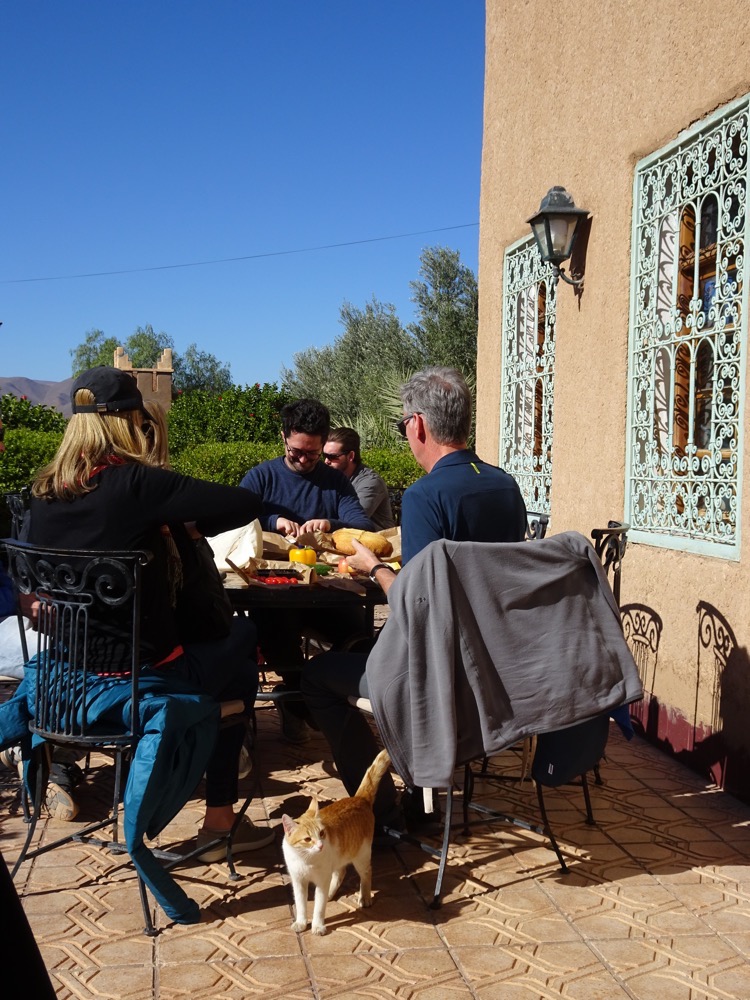 Anyway. Another day another earworm. Every time Samirr mentioned the oasis, I could hear ‘Midnight at the oasis, send your camel to bed…’ going through my head. We followed the palms and the mountains for a few hours.
Anyway. Another day another earworm. Every time Samirr mentioned the oasis, I could hear ‘Midnight at the oasis, send your camel to bed…’ going through my head. We followed the palms and the mountains for a few hours. With beautiful, typically Moroccan vistas in every direction – this is more like what I expected Morocco to look like, not the lush green rolling hills of the north. This was the only that I actually saw the water source that was sustaining all this growth: the Draa River which feeds the entire valley.
With beautiful, typically Moroccan vistas in every direction – this is more like what I expected Morocco to look like, not the lush green rolling hills of the north. This was the only that I actually saw the water source that was sustaining all this growth: the Draa River which feeds the entire valley. 
 We did one stop and it was date palms as far as the eye could see.
We did one stop and it was date palms as far as the eye could see.
 Eventually, our drive came to an end and we arrived at Zagora. Zagora is the major town in the Draa River valley. So anyone in the entire Drâa-Tafilalet region in this part of the country comes here for major supplies. The town is flanked by the mountain Zagora from which it derives its name.
Eventually, our drive came to an end and we arrived at Zagora. Zagora is the major town in the Draa River valley. So anyone in the entire Drâa-Tafilalet region in this part of the country comes here for major supplies. The town is flanked by the mountain Zagora from which it derives its name. Pretty swish for being in the middle of nowhere.
Pretty swish for being in the middle of nowhere.
 After we got settled, we went for a ‘gently walk for an hour and a half through the date palm trees of the oasis’, which turned out to be nearly a 6km walk, an easy third of which was over fucking sand dunes. Nice one! I wasn’t wearing my boots, just sneakers, and was exhausted from five hours being jostled around in the bus for most of the day, and here were expecting a nice easy walk in the cool of the palm trees, and instead, we were slogging over two kms of fucking sand dunes to see… well, I still don’t really know what?!
After we got settled, we went for a ‘gently walk for an hour and a half through the date palm trees of the oasis’, which turned out to be nearly a 6km walk, an easy third of which was over fucking sand dunes. Nice one! I wasn’t wearing my boots, just sneakers, and was exhausted from five hours being jostled around in the bus for most of the day, and here were expecting a nice easy walk in the cool of the palm trees, and instead, we were slogging over two kms of fucking sand dunes to see… well, I still don’t really know what?! Following the paths through the palm trees in the oasis was a bit like winding through a medina – lots of nooks and crannies, cool door ways and arches.
Following the paths through the palm trees in the oasis was a bit like winding through a medina – lots of nooks and crannies, cool door ways and arches.
 Many impressive building facades and doorways, that you would never know was in here among the palms.
Many impressive building facades and doorways, that you would never know was in here among the palms.
 At the base of the palms, there are small spaces of other produce being grown – turnips, henna, lucerne, alfalfa and the like.
At the base of the palms, there are small spaces of other produce being grown – turnips, henna, lucerne, alfalfa and the like. Samirr demonstrating how the locals climb the palm trees to trim the fronds off the trees. The trees themselves can live and keep bearing fruit for a century, but the fronds get cut off every five years or so. These fronds are used as a building material – primarily in the building of fences.
Samirr demonstrating how the locals climb the palm trees to trim the fronds off the trees. The trees themselves can live and keep bearing fruit for a century, but the fronds get cut off every five years or so. These fronds are used as a building material – primarily in the building of fences.



 Here is where we saw the fronds coming into use as fencing – the oasis is a naturally occurring space thanks to the river that runs through the valley, but the Sahara is an ever-changing landscape that encroaches and retreats where it pleases. Here, in the oasis, the people have learned how to try and keep the Sahara at bay, by making fences to stop the sand dunes from overrunning their water sources and changing the geography. They weave the fronds into fences which are then laid out in a grid or checked type arrangement, so when the sand storms come, they hold back the sands.
Here is where we saw the fronds coming into use as fencing – the oasis is a naturally occurring space thanks to the river that runs through the valley, but the Sahara is an ever-changing landscape that encroaches and retreats where it pleases. Here, in the oasis, the people have learned how to try and keep the Sahara at bay, by making fences to stop the sand dunes from overrunning their water sources and changing the geography. They weave the fronds into fences which are then laid out in a grid or checked type arrangement, so when the sand storms come, they hold back the sands. Fresh fencing.
Fresh fencing.
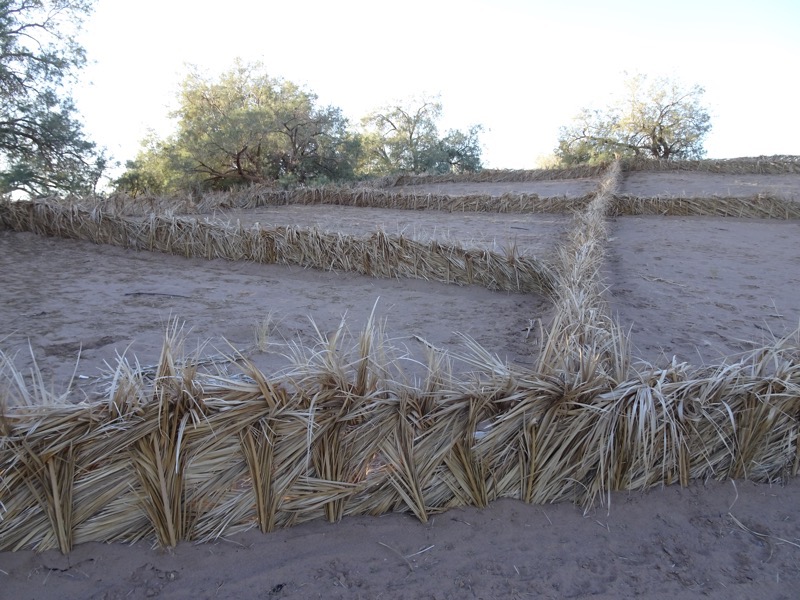 It was roughly at this point that I got sick of the walk in the sand dunes and lost the energy to look around me properly and keep taking photos – I was in a lot of pain, was trying not to throw up, and working hard on reminding myself to keep breathing. But it’s one of those shitty things – I was kinda committed, and it’s hard to know whether to pull the pin or not, because at this point it could be further to try and walk back the way we came than to keep going to fuck knows where? Additionally, I don’t want to impact the entire group’s walk just because I’m falling apart – some of them might have actually been enjoying this?! Samirr had told us we were going for a ‘gentle walk through the palms’ but here we were up and down small sand dunes and my hips and back were like ‘wtf this doesn’t resemble the brochure’ – I had zero energy for it but had to keep plodding on. Eventually, our walk went ended back at a Riad I recognised called La Soleil du Monde, where I could have waited for the mad bastards that actually wanted to walk 2kms in the sand to see very little more of I know not what? :/
It was roughly at this point that I got sick of the walk in the sand dunes and lost the energy to look around me properly and keep taking photos – I was in a lot of pain, was trying not to throw up, and working hard on reminding myself to keep breathing. But it’s one of those shitty things – I was kinda committed, and it’s hard to know whether to pull the pin or not, because at this point it could be further to try and walk back the way we came than to keep going to fuck knows where? Additionally, I don’t want to impact the entire group’s walk just because I’m falling apart – some of them might have actually been enjoying this?! Samirr had told us we were going for a ‘gentle walk through the palms’ but here we were up and down small sand dunes and my hips and back were like ‘wtf this doesn’t resemble the brochure’ – I had zero energy for it but had to keep plodding on. Eventually, our walk went ended back at a Riad I recognised called La Soleil du Monde, where I could have waited for the mad bastards that actually wanted to walk 2kms in the sand to see very little more of I know not what? :/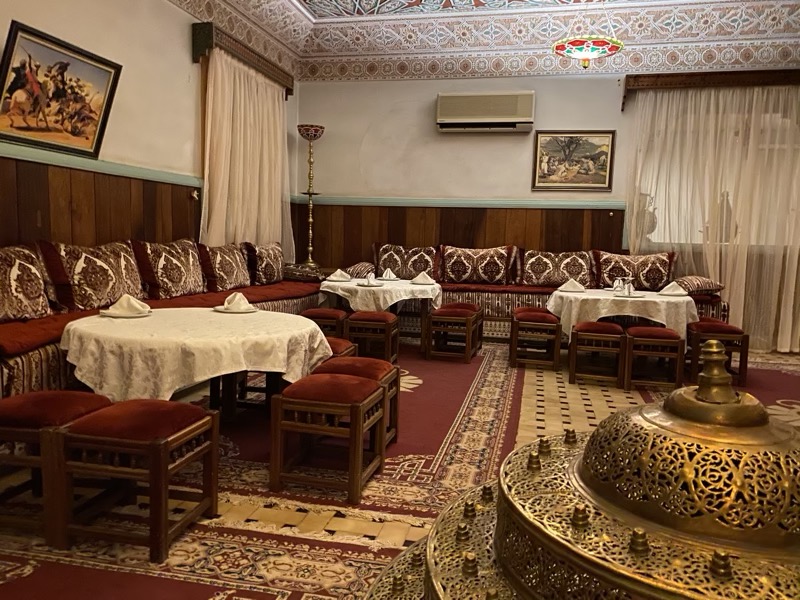



 We passed quite a few mules on our way down the road – none of them was Frank.
We passed quite a few mules on our way down the road – none of them was Frank.
 After we returned to Imlil, we collected our larger items of luggage and jumped into the minibus. We had a six hour drive ahead of us and I was not looking forward to it. The landscape was very changeable as we wound along the roads through the High Atlas Mountains.
After we returned to Imlil, we collected our larger items of luggage and jumped into the minibus. We had a six hour drive ahead of us and I was not looking forward to it. The landscape was very changeable as we wound along the roads through the High Atlas Mountains.
 Around 1300, we stopped for a barbeque lunch… there was meat hanging on the street and smoke everywhere with about half a dozen BBQ restaurants all in a row largely catering to truck drivers and tourists.
Around 1300, we stopped for a barbeque lunch… there was meat hanging on the street and smoke everywhere with about half a dozen BBQ restaurants all in a row largely catering to truck drivers and tourists. Out the back of the row of restaurants was a small bridge leading to a patio dining area.
Out the back of the row of restaurants was a small bridge leading to a patio dining area. After a meat-heavy meal we hit the road again – the landscape was much more like I expected from Morocco, unlike the north of the country that was so green and lush.
After a meat-heavy meal we hit the road again – the landscape was much more like I expected from Morocco, unlike the north of the country that was so green and lush. Another stop to have a look at a fossil and gemstone store. With no fancy cut stones, or any jewellery to hunt through, the women were largely back on the bus in no time – the men, however, fossicked through the fossils and geodes for quite a while. Several of our party bought a few pieces to take back home.
Another stop to have a look at a fossil and gemstone store. With no fancy cut stones, or any jewellery to hunt through, the women were largely back on the bus in no time – the men, however, fossicked through the fossils and geodes for quite a while. Several of our party bought a few pieces to take back home. A roadside puppy was perched high on a rock overlooking the construction site – a large part of this road was being rebuilt into a proper dual carriageway. Samirr said the contractors in the north were doing a great job, but the contractors in the south were lazy and working with old equipment – we can vouch for that! The ones that were working south of the pass were on machines belching out massive clouds of black smoke. Gross!
A roadside puppy was perched high on a rock overlooking the construction site – a large part of this road was being rebuilt into a proper dual carriageway. Samirr said the contractors in the north were doing a great job, but the contractors in the south were lazy and working with old equipment – we can vouch for that! The ones that were working south of the pass were on machines belching out massive clouds of black smoke. Gross!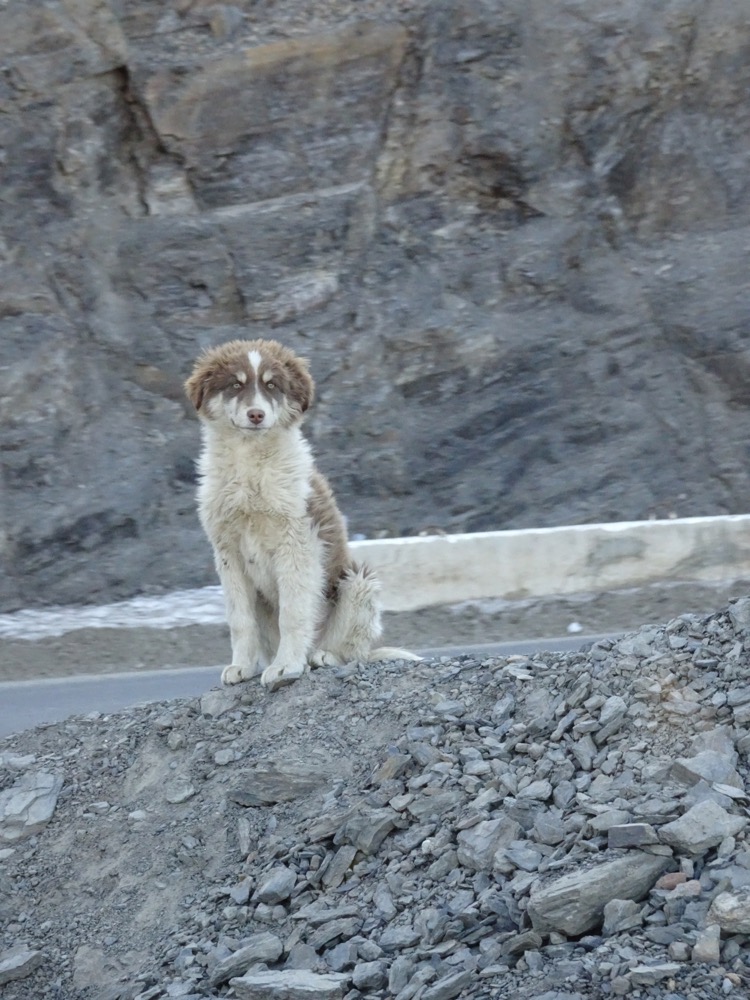
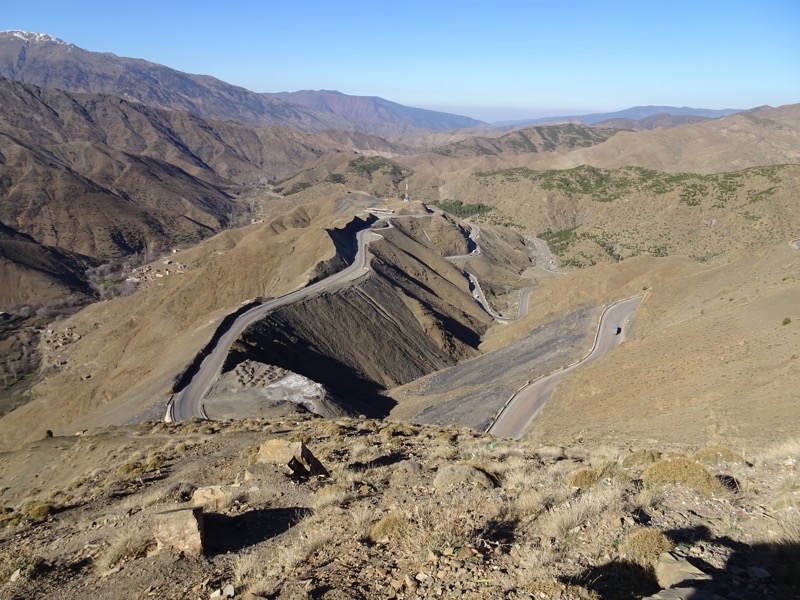 The landscapes were really quite pretty and we had several opportunities for photo stops, and to stretch the legs a bit.
The landscapes were really quite pretty and we had several opportunities for photo stops, and to stretch the legs a bit. These guys had their trinkets set up beside the snow markets… the yellow and red poles are to tell drivers how deep the snow is and to show the edge of the road. By mid-January, these guys won’t be able to hang out here.e
These guys had their trinkets set up beside the snow markets… the yellow and red poles are to tell drivers how deep the snow is and to show the edge of the road. By mid-January, these guys won’t be able to hang out here.e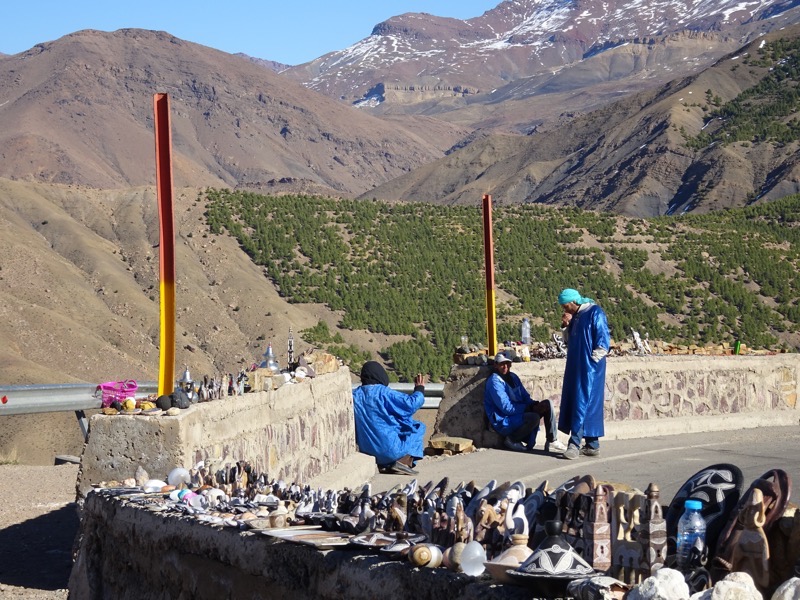
 After what seemed an interminably long time to be stuck in the bus, we made it to Ait Benhaddou. We walked through the modern side of the town to get to the picturesque ‘movie set’ side of the town.
After what seemed an interminably long time to be stuck in the bus, we made it to Ait Benhaddou. We walked through the modern side of the town to get to the picturesque ‘movie set’ side of the town.
 Aït Benhaddou is a great example of Moroccan earthen clay architecture, it was built in the 17thC and sufferred only a little under French occupation in the early 20thC, so it is incredibly well preserved It was declared a UNESCO World Heritage Site in 1987 and has been a popular place for tourist to visit due to its unique beauty and connection to Hollywood films.
Aït Benhaddou is a great example of Moroccan earthen clay architecture, it was built in the 17thC and sufferred only a little under French occupation in the early 20thC, so it is incredibly well preserved It was declared a UNESCO World Heritage Site in 1987 and has been a popular place for tourist to visit due to its unique beauty and connection to Hollywood films.


 Below is the space used as a slave market and later a fighting arena for the movie, Gladiator.
Below is the space used as a slave market and later a fighting arena for the movie, Gladiator.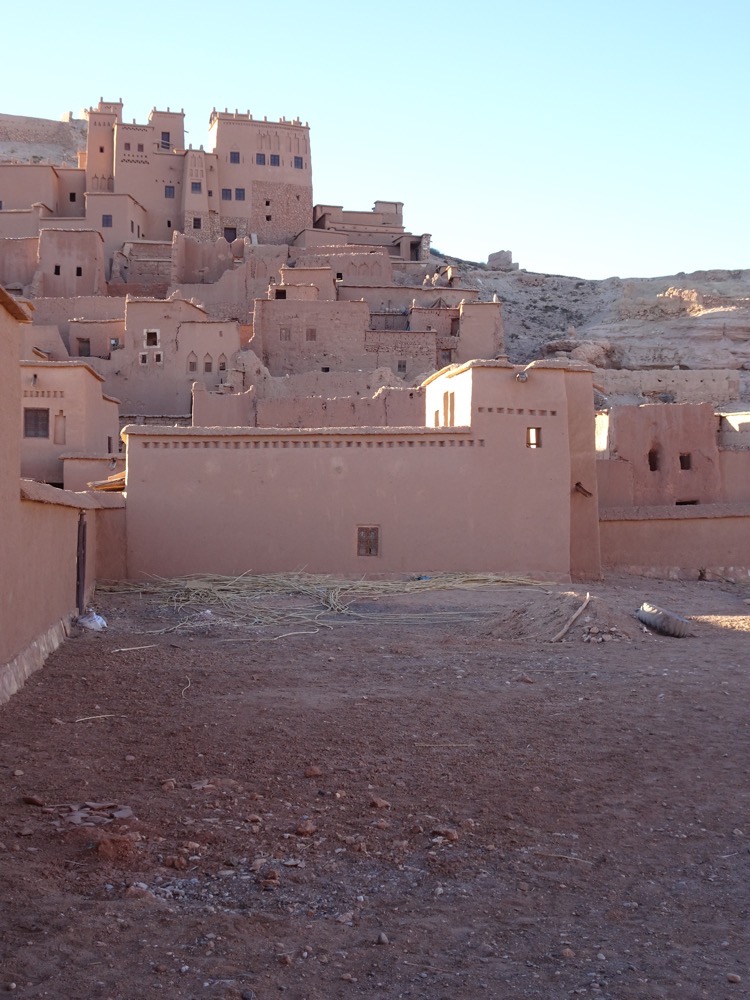
 It’s a particularly pretty and very well kept city.
It’s a particularly pretty and very well kept city.

 Wandering the streets was interesting – cute little alleyways, and fun little shops. I stupidly made the mistake of pottering around by myself, and had several men trying to lead me into their dark little shops!
Wandering the streets was interesting – cute little alleyways, and fun little shops. I stupidly made the mistake of pottering around by myself, and had several men trying to lead me into their dark little shops! 


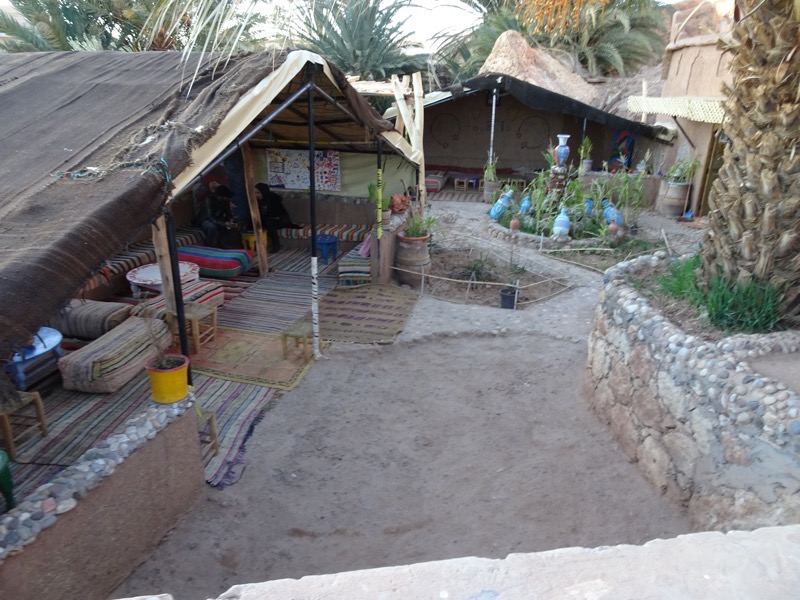 The views from the top of the kasbah:
The views from the top of the kasbah:

 After this, we made our way down to our hotel, where we managed to get ourselves half sorted. We also got to enjoy a cous cous cooking demonstration.
After this, we made our way down to our hotel, where we managed to get ourselves half sorted. We also got to enjoy a cous cous cooking demonstration.
 After this we found ourselves settled into the upstairs terrace to see in the New Year, ther was beer (oh so much beer – thanks to a language communication error with the driver Mohammed who collected supplies for us while we were up at the Berber guest house!) and wine and late night pizza snacks. Everyone had a wonderful night and I slept like a baby for the first night since we arrived in Morocco. Yay for the muscle relaxant effects of alcohol!
After this we found ourselves settled into the upstairs terrace to see in the New Year, ther was beer (oh so much beer – thanks to a language communication error with the driver Mohammed who collected supplies for us while we were up at the Berber guest house!) and wine and late night pizza snacks. Everyone had a wonderful night and I slept like a baby for the first night since we arrived in Morocco. Yay for the muscle relaxant effects of alcohol! Happy New Year from Morocco!
Happy New Year from Morocco!